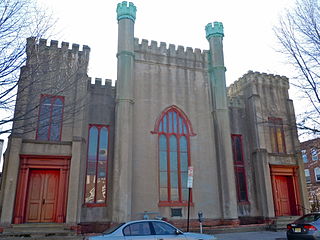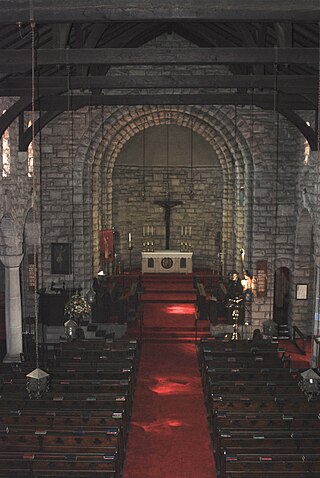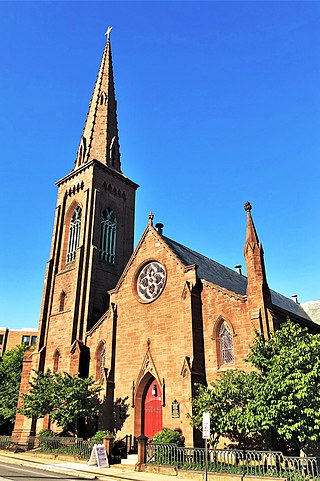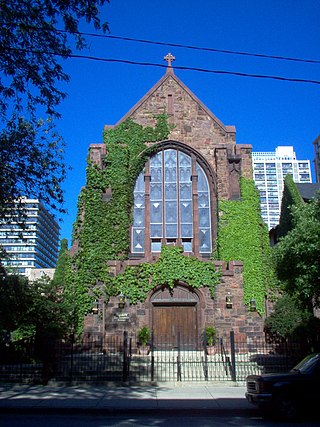Related Research Articles

Christ Church or Christ Episcopal Church is a historic Episcopal church in New Brunswick, Middlesex County, New Jersey.

The Cathedral Church of Saint Matthew, known simply as St. Matthew's Cathedral, is an Episcopal cathedral church located at 5100 Ross Avenue in Dallas, Texas, in the United States.

The St. Luke and St. Paul Episcopal Church, located on Coming Street in Charleston, is the cathedral of the Anglican Diocese of South Carolina. It was originally known as St. Paul's Radcliffeboro.

St. John's Cathedral located at 413 Cumberland Avenue in Knoxville, Tennessee, is the cathedral church of the Episcopal Diocese of East Tennessee.
St. George's Episcopal Church is a church in Fredericksburg, Virginia at 905 Princess Anne Street. The church, built in the 18th century and re-built in 1815 and 1849, is a part of the Episcopal Diocese of Virginia. The building was listed on the National Register of Historic Places in 2019.

The Church of the Ascension and Saint Agnes is an Episcopal church building located at 1215 Massachusetts Avenue in Northwest Washington, D.C., US. The current structure built in 1874 as the Church of the Ascension was added to the National Register of Historic Places in 1984. In the late 1940s, the Church of the Ascension merged with the nearby St. Agnes Episcopal Church and adopted its present name, under which it has continued as an active parish in the Episcopal Diocese of Washington.

Established in 1703, St. Michael's Church in downtown Trenton, Mercer County, New Jersey, United States, is a founding parish of the Episcopal Diocese of New Jersey. Its present building located at 140 North Warren Street was built in 1747–1748, and was renovated in 1810 and 1847–1848. It was listed on the National Register of Historic Places on April 29, 1982 as St. Michael's Episcopal Church.
Holy Apostles Episcopal Church, is an historic Carpenter Gothic church building now located at 505 Grant Avenue in Satellite Beach, Florida in the United States. It was built in 1902 some 60 miles to the south in Fort Pierce to serve St. Andrew's Episcopal Church, which it did until March 25, 1959, when St. Andrew's moved into a much larger structure and gave its old building, less its organ and stained glass windows, to the old Episcopal Diocese of South Florida to be used as a mission church. The diocese gave it to Holy Apostles, which had been formed in 1957 and had been holding services in a synagogue, and it was barged up the Indian River on July 14, 1959 to Satellite Beach, where it became the first church building in that two-year-old city just south of Patrick Space Force Base.

St. Luke's and St. Margaret's Church is a former parish of the Episcopal Diocese of Massachusetts in the Allston neighborhood of Boston. It was closed in 2010.
The Church of the Incarnation is a parish of the Diocese of Dallas of the Episcopal Church, located at 3966 McKinney Avenue in Dallas, Texas.

St Boniface Church is the mother church of the Anglican parish of Germiston, Gauteng which also includes the chapelries of St Mary and St John in Lambton, and St Mark in Rosedeep. The parish is part of the Diocese of the Highveld, which is in turn part of the Anglican Church of Southern Africa.

St. Paul's Episcopal Cathedral, is located in downtown Des Moines, Iowa, United States. It is the cathedral church of the Episcopal Diocese of Iowa. The building was listed on the National Register of Historic Places as St. Paul's Episcopal Church.

St. Stephen's Episcopal Church is an historic Carpenter Gothic style Episcopal Church church building located in Newton, Iowa, United States. Completed in 1881, it was built by the contractor David S. Strover and master carpenter Joe Stevens. On September 22, 1977, it was listed on the National Register of Historic Places. It serves a parish church in the Episcopal Diocese of Iowa.

St. James Episcopal Church at 76 Federal Street at the corner of Huntington Street in New London, Connecticut is a historic church in the Episcopal Diocese of Connecticut. The congregation was founded in 1725, and the current church – the congregation's third – was built from 1847 to 1850 to designs in the Gothic Revival style by Richard Upjohn.

The Church of Saint Luke and The Epiphany is an Episcopal congregation located at 330 South 13th Street between Spruce and Pine Streets in the Center City neighborhood of Philadelphia, Pennsylvania. It is part of the Diocese of Pennsylvania. The church was formed in 1898 as a result of the merger of St. Luke's Church (1839) and The Church of The Epiphany (1834), which consolidated at St. Luke's location.
John D. McCarty was the first missionary Episcopal priest in the Washington Territory. He served as the only United States Army chaplain at the front during the Mexican War. He was instrumental in founding and establishing numerous Episcopal churches in Western New York and the Northwest.

The Episcopal Church of the Atonement and Parish House is a historic church building at 5751 North Kenmore Avenue in Chicago, Illinois. The Gothic Revival building was constructed in 1889 and added to the National Register of Historic Places in 2009.

All Saints Episcopal Church is a parish of the Episcopal Diocese of Southeast Florida founded in the year 1912. and located in downtown Fort Lauderdale, Florida
Albert S. Nicholson was a prominent religious leader of Clark County in what was then the Washington Territory, as well as a civic leader and educator.
St. Luke's Episcopal Church is located at 615 Vermillion Street in historic downtown Hastings, Minnesota, United States.
References
- 1 2 3 4 5 6 7 8 9 10 11 12 13 14 15 Scott, Lesla E. (1992). The History of St. Luke's Church. St. Luke's Episcopal Church.
- 1 2 "Religion and Education" . Retrieved February 16, 2012.
- ↑ "A Brief History of Trinity Cathedral". Archived from the original on July 28, 2011. Retrieved November 28, 2011.
- ↑ "St. Luke's Episcopal Church". Vancouver Chronicle Souvenir Edition. Vancouver, Washington. June 1907.
- ↑ "advertisement". Vancouver Independent. Vancouver, WT. January 10, 1878.
- ↑ "Historic St. Luke's Church Burned Down". The Columbian. Vancouver, Washington. December 7, 1931.
- ↑ "First Annual Antique Show Now In Progress as Benefit for Youthful Recreation". The Columbian. Vancouver, Washington. November 12, 1948.
- ↑ "New Bell Rings Out". Vancouver Independent. Vancouver, WT. July 15, 1882.
- ↑ "Memorial". Oregon/Washington-Territory Churchman. Vancouver, WT. July 13, 1876.